Despite the above-average yields in recent years, there has been reports of ear formation issues (Elmore et al., 2016; McMechan et al., 2017; and Ortez et al., 2019) in corn that ranged from sites in the Texas Panhandle, Colorado, Nebraska, Iowa, and Illinois. One of the on-going hypotheses in our research work is that uneven or delayed emergence of corn plants may be a factor contributing to those issues. Differences in soil moisture, soil temperature, and seeding depth may result in delayed or uneven emergence of corn plants in the field. In addition, several other factors such as insect feeding, disease pressure, soil crusting, and herbicide injury can cause a delay in emergence. Adverse climatic conditions such as rains and cold soils during planting time can push growers for either earlier or later planting dates. In 2006, Abendroth and Elmore studied the yield effect of uneven corn heights and concluded that a yield reduction is found with late-emerging plants (i.e. uneven field emergence).
Some research has been published describing factors that affect corn ear development such as herbicides at V3-V4 stages (Cox et al., 2006), planting density (Sangoi, L., 2001), environmental conditions, insect damage, as well as many other biotic and abiotic factors/stresses. These factors can result in corn ear issues and can produce significant decreases in yield. In 2016, three ear formation symptoms observed during the growing season (and subsequent years) were:
- Short husk with normal ear length (Short-Husk Ear)
- Barbell/dumbbell-shaped ears (Barbell Ear)
- Multiple ears per node (Multi-Ear)

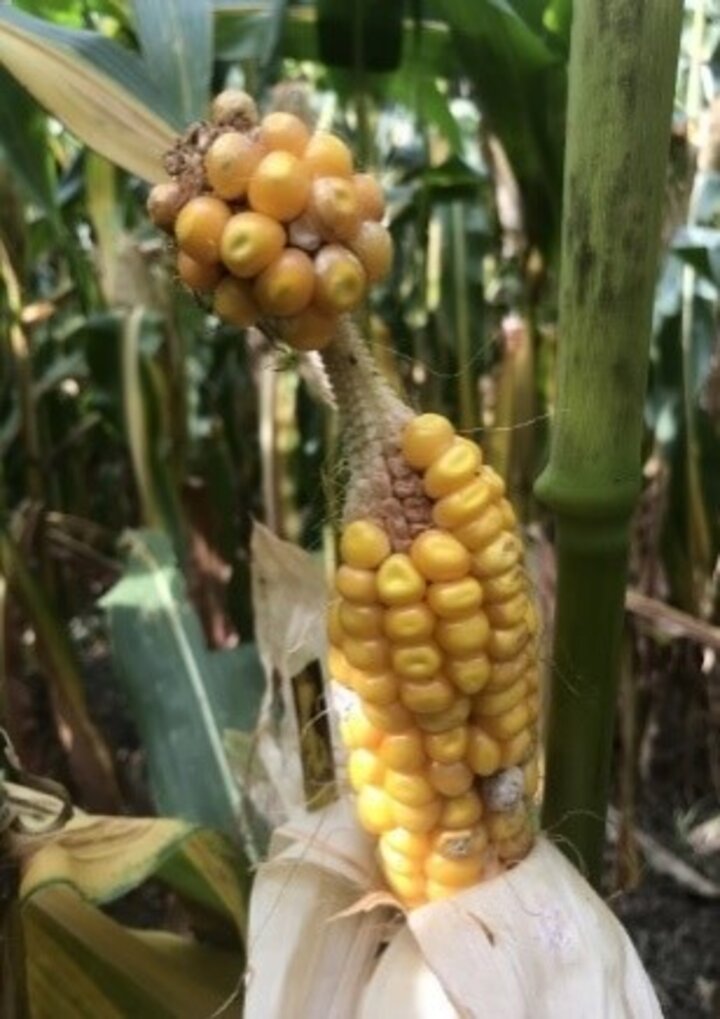
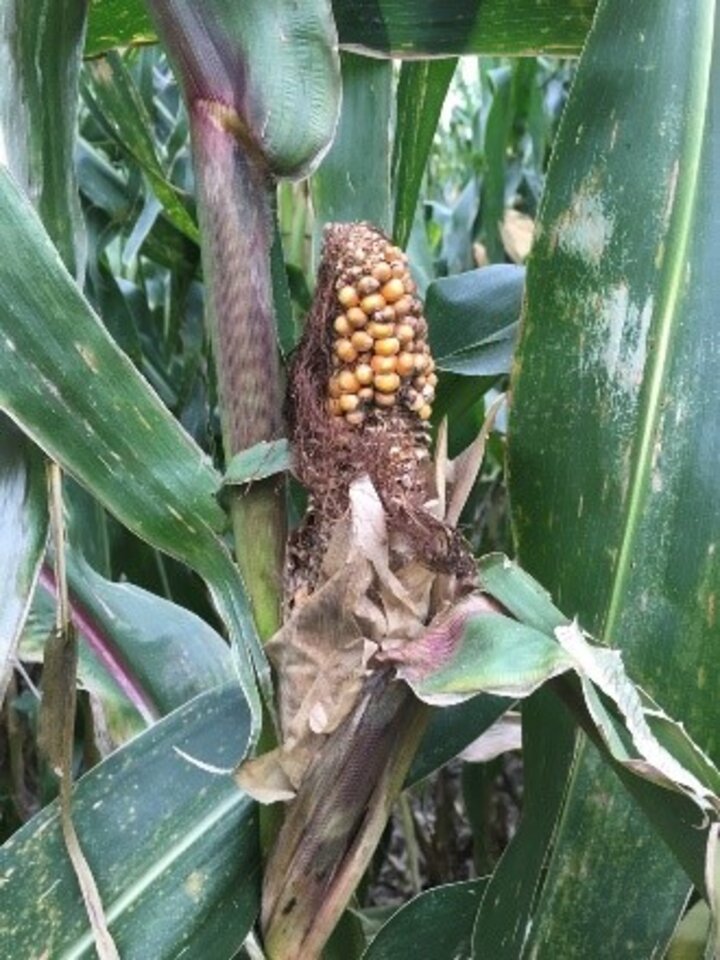
After the 2016 events, more ear issues were documented in the region (2017, 2018, and 2019) but in fewer fields and with less frequency (Ortez et al., 2019). Although no specific factor for ear issues has been identified, several different factors can likely contribute to abnormal corn ear development including genetics, abiotic and biotic stress, environmental conditions, and management practices. Widespread deformities (ear types) have been found in the same fields. We hypothesize that planting date, and thus seedling emergence timing, might have an impact on corn growth and ear issues.
Objectives
The objectives of this experiment were to investigate the effect of planting dates and two corn hybrids on: 1. Stem diameter; 2. Internode length; 3. Ear height; 4. Leaf height; and 5. Ear issues
This is a continuation of work started in 2018 (Farabaugh et al., 2019), methodology follows.
Methodology
Location. The project was conducted under field conditions during the 2019 growing season at the Eastern Nebraska Research and Extension Center (ENREC) near Mead, Nebraska. The experiment was planted on a field previously planted with soybeans (2018 season). The research field had a linear irrigation system that was utilized for water supply; a base fertilizer was applied before planting.
Treatments. A susceptible (ear issues observed in the past) and a non-susceptible (no ear issues observed, check) hybrid were planted in about 15-day intervals over six weeks (April 15 to May 31, 2019) from the first planting date (April 15, 2019). All plots were planted at 34,000 seeds per acre.
Experimental Design. The experiment was arranged as a split-plot randomized complete block design with four replications. The main plot was the planting date and the subplot hybrid. Experimental plots consisted of four rows spaced at 30-inches. Plots were 10 feet wide by 30 feet long.
Plant Measurements. All measurements were collected at R5, dent stage when all plant characteristics we measured were developed to their maximum potentials (Abendroth et al., 2011). Ten plants per plot were randomly marked and measured as follows:
- Stem diameter: measured at the ground/soil level.
- Internode length: each internode measured from the ground level to about node 19.
- Ear height: measured from the ground level to the ear node.
- Leaf height: measured from the ground level to the last developed collared leaf – the flag leaf.
Ear Issue Assessment. Collected individually from the 10 marked plants after ears were fully formed (R5, dent stage).
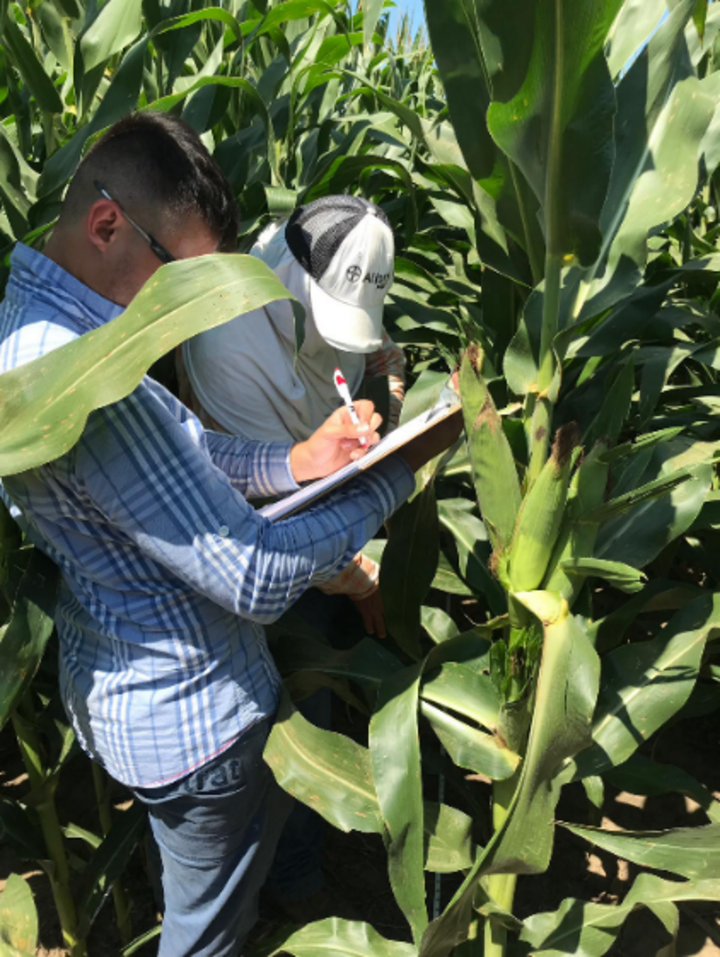

Results
1. Planting Date and Hybrid Effects on Stem Diameter, Ground/Soil Level
The effects of four planting dates and two hybrids on stem diameter are shown in Figure 1. Planting date and hybrids did not influence stem diameter, and no interaction was observed between the two factors either. By the R5 stage (dented kernels), when data was collected, it is clear that planting dates and its interaction with hybrids did not affect stem diameter. However, there may be a difference between hybrids - but we were not able to discern that with our procedures.
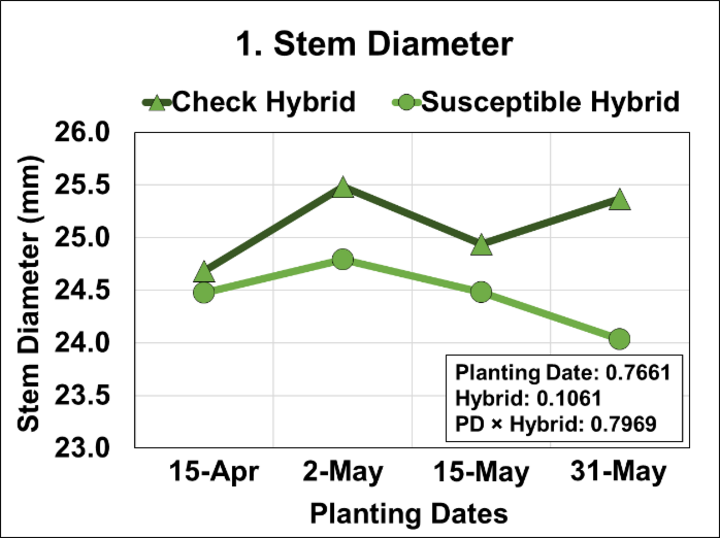
2. Planting Date and Hybrid Effects on Internode Length
The effects of four planting dates and two hybrids in plant internode length are presented in Figure 2. The planting date effect was not significant, although the figure shows a slight increase in length in the two hybrids for the last planting date (May 31) – but we cannot say that with confidence since the comparison was not significant based on the probability levels required for the significance that we predetermined. The susceptible hybrid predominantly had slightly greater internode length than the check. No interaction was observed between planting date and hybrid. These results suggest that late emerged plants (last planting date) developed differently than those early planted. This rationale couples well with the susceptible hybrid trend observed in Figure 1, where thinner stem diameter was observed for later planting dates. In other words, the longer internode lengths of the later planted susceptible hybrid had to come from growth reallocation, in this case at the cost of thinner stem diameters.

3. Planting Date and Hybrid Effects on Ear Placement, Height
There was a significant interaction between planting dates and hybrid on the ear heights, Figure 3. The check hybrid had higher ear placement, between 120 and 135 cm (English units) from the ground level. By the R5 stage (dent), planting dates showed similarities in ear height despite a maximum of 45 days difference in planting. The fourth planting date seemed to affect the two hybrids differently; the check hybrid increased ear height whereas the susceptible hybrid decreased its ear height.

4. Planting Date and Hybrid Effects on Leaf Height, Flag Leaf
There was close to significant interaction between planting dates and hybrids on the height of the last developed leaf – flag leaf; likely influenced by the May 15 deviation/drop in the check hybrid relative to the susceptible. Figure 4 shows the significant effects of planting dates and hybrids. For both hybrids, the first three planting dates had lower flag leaf heights. By the R5 stage, the first three planting dates showed similarities in flag leaf height despite a maximum of 30 days difference in planting dates, but there was a significant increase in height for the last planting date for both hybrids. Greater leaf heights for the last planting date may have been influenced by the increase in internode lengths observed in Figure 2.
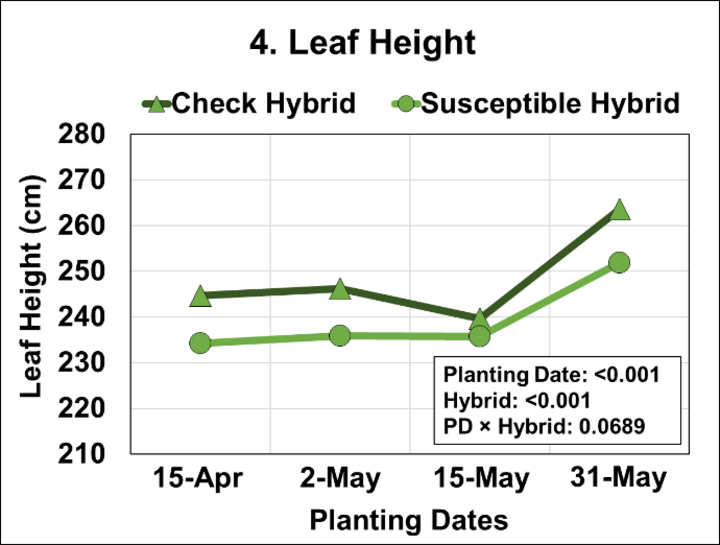
5. Planting Date and Hybrid Effects on Ear Issues
There was no significant interaction between planting dates and hybrids on the cumulative (across all plots) number of ear issues recorded. Nonetheless, Figure 5 shows the significant effects of the individual main effects. Planting dates one and four resulted in fewer recorded issues, whereas plantings 2 and 3 show more issues. As for hybrids, the susceptible hybrid showed more issues across all planting dates ranging between 23 and 40 affected plants while the check hybrid had the lower results ranging between 0 and 10 affected plants; 40 plants were sampled in each hybrid and for each date of planting.
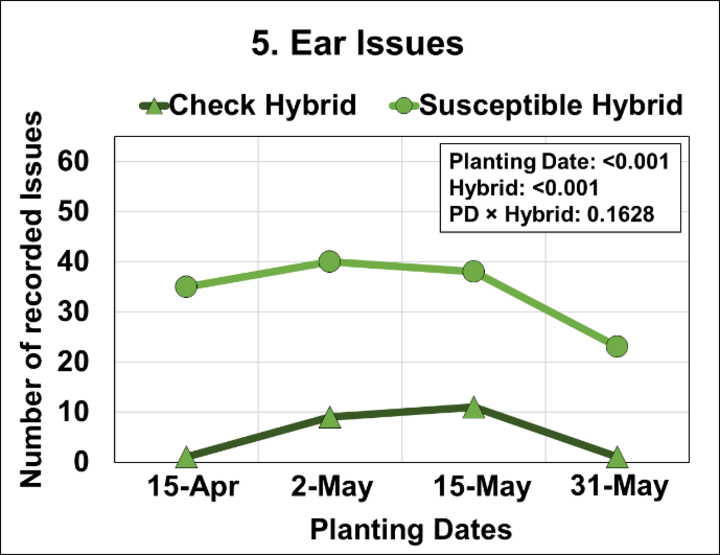
Conclusions
Stem diameter changes were not evident for either planting dates or hybrids. Internode lengths for the last planting date were visibly longer than those of the first three planting dates. It is reasonable to assume that the plants in the last planting allocated more of their resources to aboveground, rapid vertical growth (more elongation), growing under warmer conditions. Ear height differences were observed for the two hybrids; the check hybrid had ears placed at greater heights. Despite up to 30 days difference in planting times, flag leaf heights of the first three planting dates were similar at the R5, dent stage. Taller flag leaf heights occurred with the latest planting date; flag leaf height was greater for the check hybrid. It is valid to assume that slightly longer internodes of the last planting date could have resulted in greater flag leaf heights as well.
Despite having three years passed since the drastic ear issue scenarios observed in 2016 cornfields across the region, similar ear issues are still present in our cornfields (but thankfully in fewer fields and at lower frequencies), reducing productivity and causing us, as researchers, to continue pondering the causes. This report covers one of the on-going research questions that we have. Additional research experiments are in progress, with the ultimate goal of better understanding the responsible factors for ear abnormalities and productivity losses in corn.
No definite recommendations on how to reduce ear abnormalities can be drawn yet, however, good hybrid selection and finding the proper planting windows for each specific condition should help.
Acknowledgment
Authors would like to thank Jenny Rees for feedback provided. Department of Agronomy & Horticulture and the Department of Entomology. Robert B. Daugherty Water for Food Global Institute (DWFI) for funding support. This project was started as part of the USDA NIFA Agriculture and Food Research Initiative–Undergraduate Experiential Learning Fellowship Program, 2018.
References
Abendroth, L.J., and R.W. Elmore. 2006. What's the yield effect of uneven corn heights? Pages 169-171 of the IC-496(15), June 12, 2006 issue. Iowa State University Extension, Ames, Iowa. Available at: https://crops.extension.iastate.edu/encyclopedia/whats-yield-effect-uneven-corn-heights
Abendroth, L.J., R.W. Elmore, M.J. Boyer, and S.K. Marlay. 2011. Corn Growth and Development. PMR 1009. Iowa State University Extension, Ames, Iowa. Available at: https://store.extension.iastate.edu/product/Corn-Growth-and-Development
Cox, W.J., R.R. Hahn, and P.J. Stachowski. 2006. Time of Weed Removal with Glyphosate Affects Corn Growth and Yield Components. Agronomy Journal 98(2): 349–353. Available at: https://dl.sciencesocieties.org/publications/aj/abstracts/98/2/349
Elmore, R., Rees, J., McMechan, J., Jackson-Ziems, T., and Hoegemeyer, T. 2016. Corn ear formation issues likely correlated with the loss of the primary ear node. The University of Nebraska Extension. CropWatch. 19 August 2016. Available at: https://cropwatch.unl.edu/2016/corn-ear-formation-issues-likely-correlated-loss-primary-ear-node
Farabaugh, K., Ortez, O., McMechan, J., Koehler, K., and Elmore, R. 2019. Planting Date Impact on Corn Growth and Ear Issues. CropWatch.12 March 2019. Available at: https://cropwatch.unl.edu/2019/planting-date-impact-corn-growth-and-ear-issues
McMechan, J., Elmore, R., and Rees, J. 2017. Crop Production Clinics Proceedings. Pages 27-29, University of Nebraska Extension. Available at: https://agronomy.unl.edu/documents/2017%20CPC%20Proceedings%20FINAL.pdf
Ortez, O., McMechan, J., Hoegemeyer, T., and Elmore, R. 2019. Corn Growth and Development: What We Have Learned About Corn Development From Studying Ear Issues. The University of Nebraska Extension. CropWatch. 23 January 2019. Available at: https://cropwatch.unl.edu/2019/corn-ear-formation-issues
Sangoi, L. 2001. Understanding Plant Density Effects on Maize Growth and Development: an Important Issue to Maximize Grain Yield. Ciência Rural 31 (1): 159–168. Available at: http://www.scielo.br/scielo.php?script=sci_arttext&pid=S0103-84782001000100027

